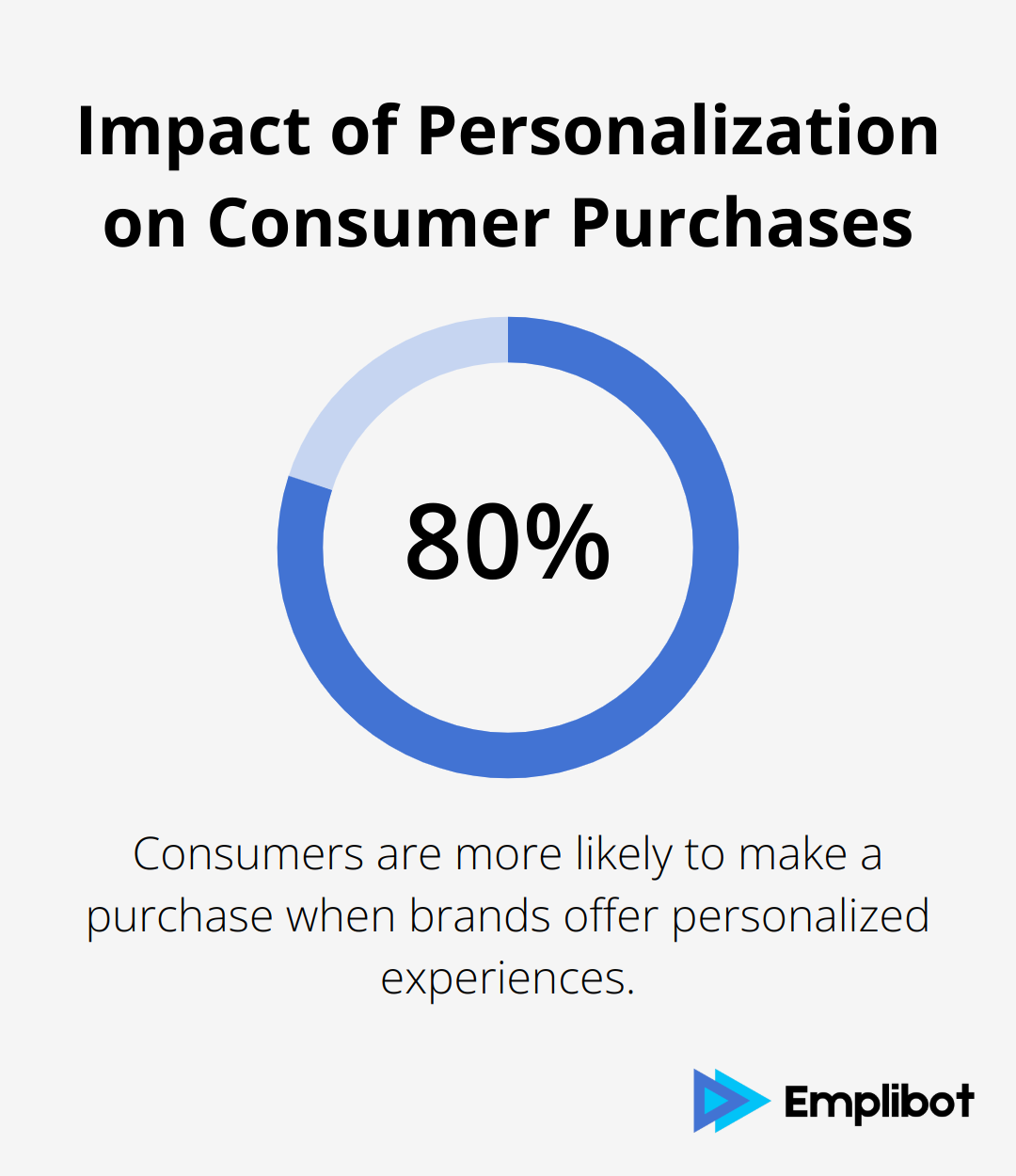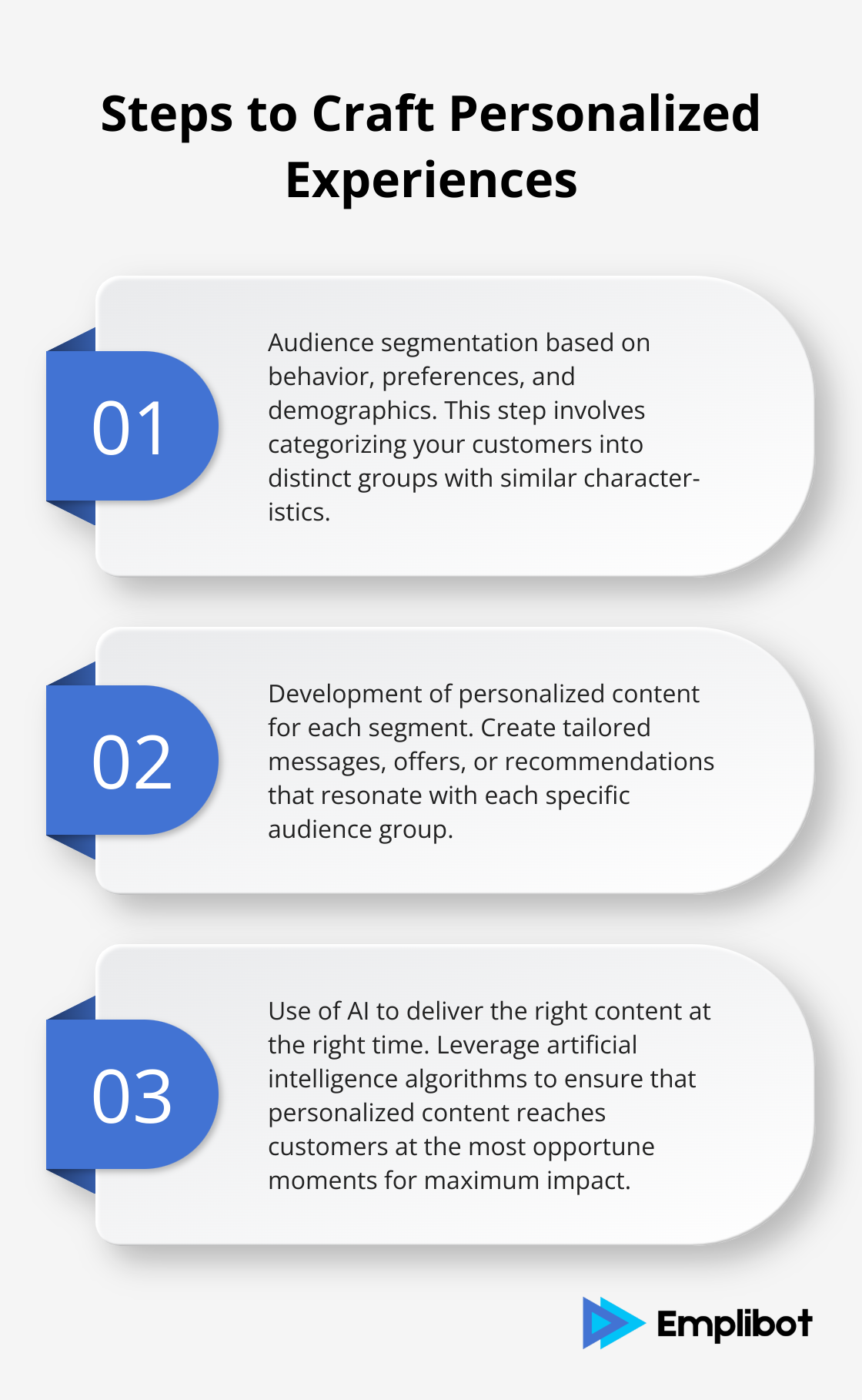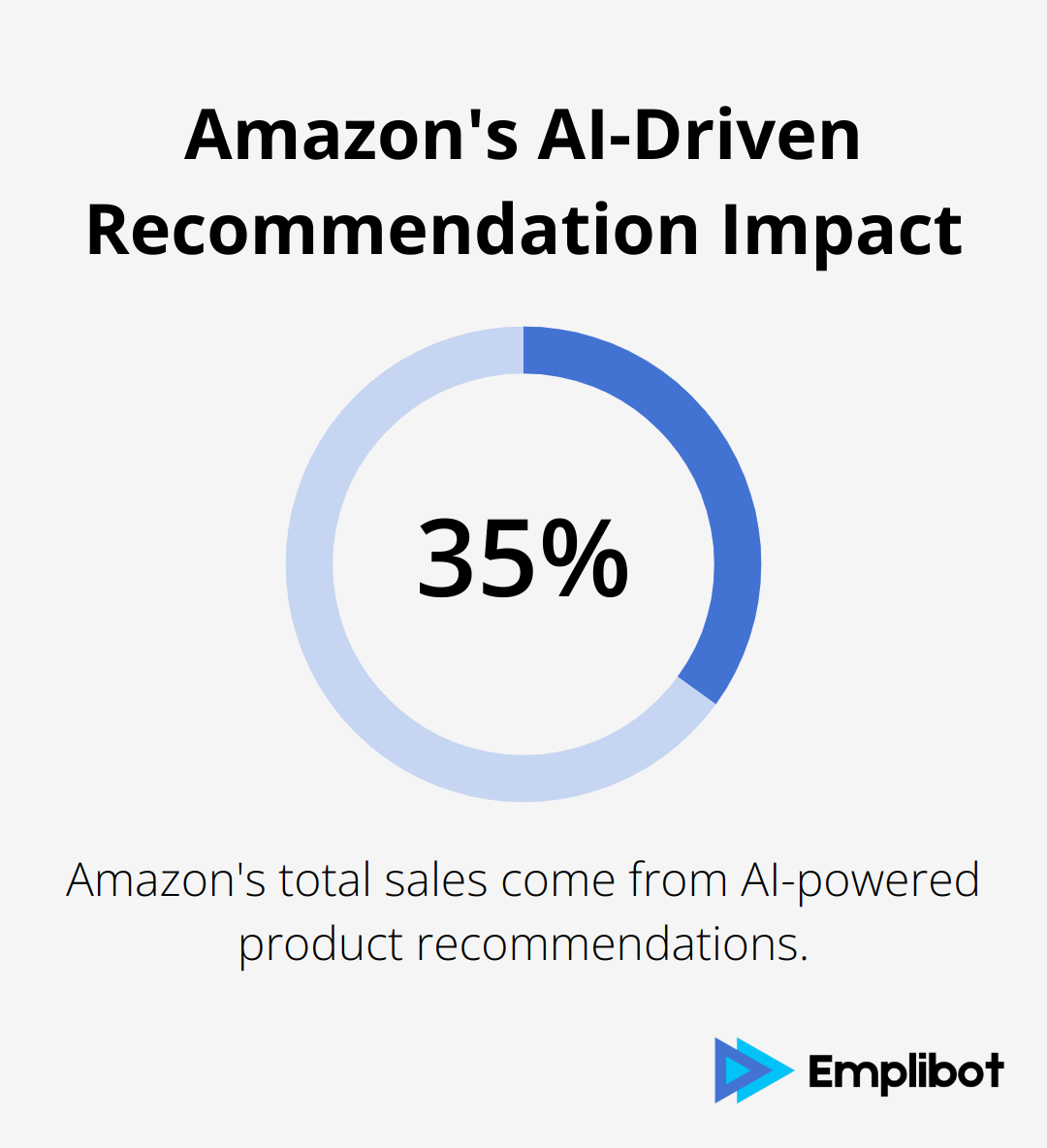AI-driven personalization is reshaping how businesses interact with their customers. By leveraging advanced algorithms and machine learning, companies can now offer tailored experiences that resonate with individual preferences and behaviors.
At Emplibot, we’ve seen firsthand how this technology transforms customer engagement and boosts satisfaction. This blog post will explore the power of AI personalization, its implementation strategies, and real-world success stories that demonstrate its impact on modern business.
What is AI-Driven Personalization?
The Revolution in Customer Experience
AI-driven personalization transforms customer experience. This process uses artificial intelligence to customize content, products, and services for individual users based on their behavior, preferences, and data. Companies that implement this technology often see significant boosts in engagement and conversion rates.
The AI Data Analysis Powerhouse
AI processes vast amounts of customer data at incredible speeds. It analyzes browsing history, purchase patterns, demographic information, and social media activity to create detailed customer profiles. This comprehensive understanding allows businesses to predict customer needs and preferences with high accuracy.
A study by Epsilon found that 80% of consumers are more likely to make a purchase when brands offer personalized experiences. This statistic highlights the importance of AI in creating tailored interactions.

Real-Time Customization
AI-driven personalization operates in real-time, which is one of its most powerful aspects. As customers interact with a website or app, AI algorithms instantly adjust the content, product recommendations, or even pricing to match their current context and intent.
Amazon’s recommendation engine exemplifies the massive impact of well-implemented AI personalization on a business’s bottom line.
Advantages for Businesses and Customers
AI personalization offers numerous benefits for businesses:
- Increased customer loyalty
- Higher conversion rates
- Improved ROI on marketing spend
Customers also reap significant benefits:
- More relevant experiences
- Less time wasted on irrelevant content
- A sense of being understood by brands
These advantages lead to higher satisfaction and stronger brand relationships.
The Path to Effective Implementation
To implement AI personalization effectively, businesses should focus on:
- Collecting high-quality data
- Selecting appropriate AI tools
- Continuously testing and refining strategies
The key lies not just in having the technology, but in using it intelligently to create meaningful connections with customers.
As we move forward, we’ll explore the specific strategies businesses can use to implement AI-driven personalization successfully. These tactics will help you harness the full potential of this powerful technology and create truly unique customer experiences.
How to Implement AI Personalization
AI personalization transforms customer experiences through strategic implementation and the right tools. This chapter outlines the key steps to harness this powerful technology effectively.
Data Collection and Organization
High-quality data forms the foundation of AI personalization. Collect customer information from various touchpoints:
- Website interactions
- Purchase history
- Email engagement
- Social media activity
- Customer support interactions
Organize this data in a centralized customer data platform (CDP). A CDP unifies information from different sources, creating a comprehensive view of each customer. CDPs help assemble customer profiles, orchestrate customer interactions, and accelerate data delivery to analytics and other systems.
Prioritize transparency when collecting data. Communicate your data usage policies clearly and obtain proper consent. This approach builds trust and ensures compliance with regulations like GDPR and CCPA.
Selecting AI Tools and Platforms
The selection of appropriate AI tools plays a critical role in successful personalization. Look for platforms that offer:
- Machine learning capabilities
- Real-time data processing
- Integration with your existing tech stack
- Scalability to grow with your business
Popular options include Adobe Target, Dynamic Yield, and Optimizely. These platforms provide robust personalization features and integrate well with various data sources.
For businesses new to AI personalization, Emplibot offers a user-friendly platform that simplifies the process. It provides automated content creation and distribution, tailored to your specific audience.
Crafting Personalized Experiences
With data and tools in place, focus on the creation of personalized content and recommendations. This process involves:

An e-commerce site might show different homepage layouts based on a user’s browsing history. A B2B company could tailor its content offerings based on a prospect’s industry and role.
Netflix exemplifies effective content personalization. Their recommendation system analyzes viewing history to suggest relevant shows and movies.
Continuous Testing and Optimization
AI personalization requires ongoing testing and refinement. Implement A/B testing to compare different personalization strategies. Setting clear goals and selecting appropriate AI tools are vital for the success of AI-powered A/B tests, ensuring relevant and actionable insights. Monitor key metrics like conversion rates, engagement, and customer lifetime value.
Use the insights from these tests to improve your personalization efforts continuously. This might involve adjustments to your AI algorithms, refinement of your content strategy, or exploration of new personalization techniques.
Amazon’s personalization strategy evolves constantly. They run numerous A/B tests annually, resulting in incremental improvements that significantly impact their bottom line.
The implementation of AI personalization marks the beginning of a journey towards more engaging customer experiences. The next chapter will explore real-world examples of successful AI personalization, providing concrete insights into its transformative power across various industries.
AI Personalization Success Stories
E-commerce Giants Lead the Way
Amazon stands out as a pioneer in AI-driven product recommendations. Their recommendation engine accounts for 35% of their total sales (according to a McKinsey study). This system analyzes past purchases, browsing history, and items in the cart to suggest relevant products. The result? A seamless shopping experience that keeps customers coming back.

Clothing retailer Stitch Fix takes personalization a step further. They combine AI algorithms with human stylists to curate personalized clothing boxes for subscribers. This hybrid approach has led to a 30% increase in customer retention rates since its implementation.
Email Marketing Gets Personal
Spotify’s Discover Weekly playlist exemplifies AI-powered email marketing done right. The platform analyzes listening habits to create a personalized playlist for each user, delivered via email every Monday. This feature now boasts 40 million users every month.
The travel industry also benefits from AI personalization. Airbnb personalizes email content based on user preferences and past bookings. This approach has resulted in a 300% increase in their email click-through rates.
Tailored User Interfaces
Netflix’s personalized user interface revolutionizes the streaming industry. Their AI algorithm doesn’t just recommend content; it customizes the artwork shown for each title based on individual viewing habits. This level of personalization has contributed to a 10% reduction in subscriber churn.
In the finance sector, Bank of America’s AI-powered virtual assistant, Erica, provides a personalized banking experience. More than 98% of clients get answers they need from Erica within 44 seconds, on average. When further assistance is needed, Bank of America’s team is ready to help.
AI-Powered Chatbots Enhance Customer Service
AI-driven chatbots have transformed customer service across industries. These intelligent assistants provide instant, personalized responses to customer queries 24/7. For example, H&M’s chatbot offers style advice based on customer preferences and purchase history, enhancing the shopping experience and increasing engagement.
Personalized Content Recommendations in Media
The New York Times uses AI to personalize content recommendations for its readers. The algorithm analyzes reading habits, time spent on articles, and topics of interest to suggest relevant stories. This personalization strategy has increased reader engagement and subscription rates.
These examples illustrate the transformative power of AI personalization across various industries. Companies leverage AI to create unique, tailored experiences, which significantly boost engagement, satisfaction, and ultimately, their bottom line.
Final Thoughts
AI-driven personalization transforms customer interactions, offering tailored experiences that boost loyalty and conversions. Companies leverage advanced algorithms to analyze customer data, predict preferences, and deliver personalized content across various touchpoints. This technology empowers businesses to create meaningful connections with their audience, resulting in improved engagement and higher ROI on marketing efforts.
The future of AI personalization promises even more sophisticated and seamless experiences for customers. Advancements in natural language processing and predictive analytics will enable businesses to anticipate customer needs with unprecedented accuracy. Integration with emerging technologies like augmented reality and the Internet of Things will create immersive, personalized experiences that blur the lines between digital and physical interactions.
We at Emplibot understand the power of AI in content marketing. Our platform automates WordPress blogs and social media, handling everything from keyword research to content creation and distribution. AI-driven personalization will continue to evolve, giving businesses that embrace this technology a significant advantage in fostering stronger customer relationships and achieving sustainable growth.

